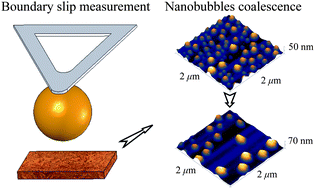The boundary condition at the solid–liquid interface on the micro/nanoscale is an important issue in micro/nanofluidic systems, where drag forces between fluids and solid walls need to be minimized. Recent studies have shown that on hydrophobic surfaces the fluid velocity near the solid surface is not equal to the velocity of the solid surface, a phenomenon called boundary slip. Theoretical and experimental studies suggest that at the solid–liquid interface, the presence of nanobubbles is responsible for boundary slip. In this review, various techniques for boundary slip investigation are described. We focus on the research performed using contact and tapping mode atomic force microscopy methods to study boundary slip on hydrophilic, hydrophobic, and superhydrophobic surfaces. The impact of surface roughness and hydrophobicity on measured slip length is discussed. The process of how to eliminate the influences of cantilever deflection and electrostatic forces on experimental measurement is discussed. Based on nanobubble imaging on a hydrophobic surface, the role of nanobubbles on boundary slip is discussed. Nanobubble movement and coalescence, as well as tip–nanobubble interactions, are discussed. The relationship between nanobubble immobility and surface structures on hydrophobic surfaces is discussed. Finally, a method to quantitatively measure sliding force on hydrophobic surfaces using atomic force microscopy is presented, and the effect of the presence of an electric field is discussed.

You have access to this article
 Please wait while we load your content...
Something went wrong. Try again?
Please wait while we load your content...
Something went wrong. Try again?


 Please wait while we load your content...
Please wait while we load your content...